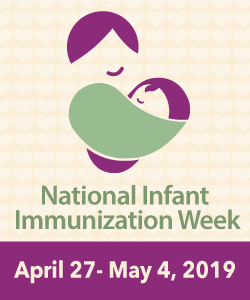
The last week of April we recognize as National Infant Immunizations Week. We’ve heard a lot of discussion about vaccines in the news lately and want to provide you with the most information possible. Vaccinations are designed to protect not only your child from serious diseases but to protect those with compromised immune systems who are unable to receive the vaccine themselves.
You can find a lot of information online, but your child’s medical provider offers the best information on immunizations. Seeing the same physician or nurse practitioner for your child’s wellness exams and illnesses supplies the provider a complete history and understanding of your child’s health. Together you and your child’s health provider can make the best decisions for your child.
What illnesses do childhood vaccines protect against?
The typical course of vaccines covers fourteen illnesses:
- Hepatitis A
- Hepatitis B
- Diphtheria
- Hib Disease (Haemophilus influenzae type b)
- Pertussis
- Pneumococcal Disease
- Polio
- Influenza (flu)
- Measles
- Mumps
- Rotavirus
- Rubella (German Measles)
- Tetanus
- Varicella (Chickenpox)
If you’re like most Americans, you’ve never heard of some of these illnesses and have never known anyone who ever experienced many of them. You can thank vaccines for that protection. Want to know more about each of these diseases? Check out this article which describes each disease and potential complications.
Why do my children receive so many vaccines at one time?
Infant immunizations and childhood vaccines are scheduled to be given when a child is most at risk of developing the disease and when a child’s body is most responsive to developing protection after the vaccine is given. Some vaccines must be given in multiple doses spaced at specific intervals to create and maintain full, optimum protection.
What’s the recommended infant immunizations schedule for children?
The CDC provides informative guides for when you should expect your child to receive specific vaccines. You should also receive an updated vaccination record when your child has new vaccines.
Download the CDC’s guide in English
Download the CDC’s guide in Spanish
Where can I have my child vaccinated?
While some pharmacies offer certain vaccines for adults, it’s important to schedule time with your child’s regular medical provider for their vaccines.
Mantachie Rural Health Care, Inc., offers vaccines to children who are covered under Medicaid or private insurance as well as children who do not have insurance. We’re also part of the federally funded Vaccines for Children program which offers vaccines at no cost to children who might not be vaccinated due to an inability to pay.
If your child has received vaccinations at another clinic, we are able to pull those reports from our office which ensures your child receives the correct vaccines in the right order.
Make an appointment for your child’s next vaccines by calling our office at (662) 282-4226.










